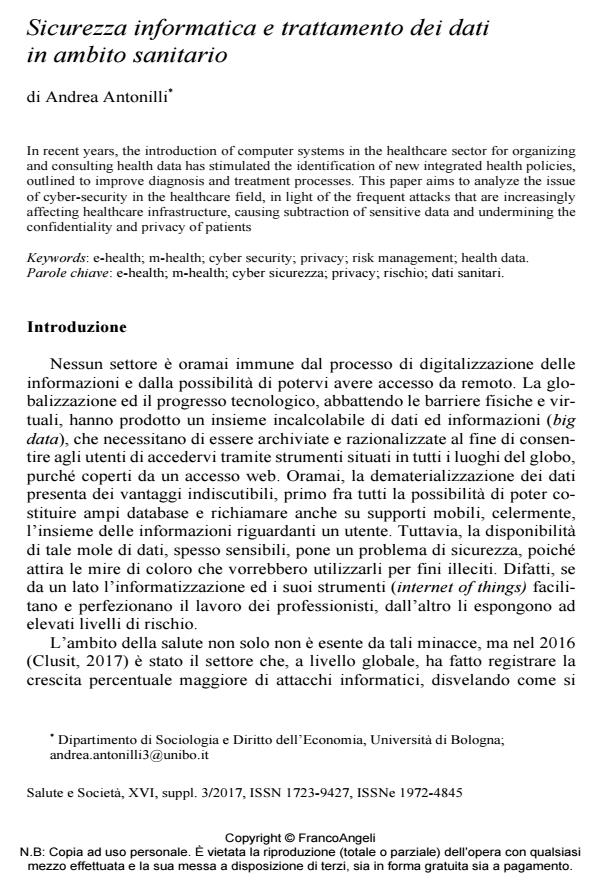Sicurezza informatica e trattamento dei dati in ambito sanitario
Titolo Rivista SALUTE E SOCIETÀ
Autori/Curatori Andrea Antonilli
Anno di pubblicazione 2017 Fascicolo 2017/3-Suppl. Lingua Italiano
Numero pagine 17 P. 84-100 Dimensione file 105 KB
DOI 10.3280/SES2017-SU3006
Il DOI è il codice a barre della proprietà intellettuale: per saperne di più
clicca qui
Qui sotto puoi vedere in anteprima la prima pagina di questo articolo.
Se questo articolo ti interessa, lo puoi acquistare (e scaricare in formato pdf) seguendo le facili indicazioni per acquistare il download credit. Acquista Download Credits per scaricare questo Articolo in formato PDF

FrancoAngeli è membro della Publishers International Linking Association, Inc (PILA)associazione indipendente e non profit per facilitare (attraverso i servizi tecnologici implementati da CrossRef.org) l’accesso degli studiosi ai contenuti digitali nelle pubblicazioni professionali e scientifiche
In recent years, the introduction of computer systems in the healthcare sector for organizing and consulting health data has stimulated the identification of new integrated health policies, outlined to improve diagnosis and treatment processes. This paper aims to analyze the issue of cyber-security in the healthcare field, in light of the frequent attacks that are increasingly affecting healthcare infrastructure, causing subtraction of sensitive data and undermining the confidentiality and privacy of patients;
Keywords:E-health; m-health; cyber sicurezza; privacy; rischio; dati sanitari.
- Cipolla C. (2013). Perché non possiamo non essere eclettici. Il sapere sociale nella web society. Milano: FrancoAngeli.
- Cipolla C., Ardissone A. (2017). Un paradigma cittadino-centrico nella m-Health. Salute e Società, 2: 11-31. DOI: 10.3280/SES2017-00200
- Cialdini R. (2013). Le armi della persuasione. Come e perché si finisce col dire di sì. Firenze: Giunti Editore.
- Clemente C. (2015). e-Health e social innovation. Salute e società, 1: 102-115. DOI: 10.3280/SES2015-00100
- Clusit (2017). Rapporto sulla sicurezza ICT in Italia. Disponibile al sito: https://clusit.it/pubblicazioni/
- European Commission (2004). E-Health. Making health care better for European citizens: an action plan for a European e-health area. Disponibile al sito: http://eur-lex.europa.eu/LexUriServ/LexUriServ.do?uri=COM:2004:0356:FIN-:EN:PDF
- European Commission (2012). E-Health Action Plan 2012-2020 – Innovative healthcare for the 21st century.
- European Commission (2014). Green Paper on Mobile Health. Disponibile al sito: https://ec.europa.eu/digital-single-market/en/news/green-paper-mobile-health-mhealth
- European Union (2016). General Data Protection Regulation. Disponibile al sito: http://eur-lex.europa.eu/legalcontent/IT/TXT/?uri=uriserv:OJ.L_.2016.119.01.-0001.01.ITA&toc=OJ:L:2016:119:TOC
- Eysenbach G. (2001). What is e-Health? Journal of Medical Internet Research, 3(2): e20.
- D’Acquisto G., Naldi M. (2017). Big Data e Privacy by Design. Anonimizzazione, Pseudonimizzazione e Sicurezza. Torino: Giappichelli Editore.
- Fernandez-Aleman J.L., Senor I.C., Lozoya P.A., Toval A. (2013). Security and privacy in electronic health records: A systematic literature review. Journal of Biomedical Informatics, 46(3): 541-562.
- Fortinet (2017). Threat Landscape Report Q2 2017. Disponibile al sito: https://it.fortinet.com/fortiguard/threat-intelligence/threat-landscape.html
- Gallotti C. (2014). Sicurezza delle informazioni – Valutazione del rischio i sistemi di gestione la norma ISO/IEC 27001:2013.
- Garante per la protezione dei dati personali (2013). La protezione dei dati nel cambiamento. Disponibile al sito: http://www.garanteprivacy.it/web/guest/home/-docweb/-/docweb-display/docweb/3182545
- Gottfredson M.R. (2004). Intelligence. Is it the Epidemiologists’ Elusive ‘Fundamental Cause’ of Social Class Inequalities in Health? Journal of Social and Personality Psychology, 86: 174-199. DOI: 10.1037/0022-3514.86.1.17
- Kickbusch I., Maag G. (2007). Lo sviluppo della Health Literacy nelle moderne società della salute. Salute e Società, 1: 185-200.
- Lloyd’s (2016). Facing the Cyber Risk Challenge. Disponibile al sito: https://www.lloyds.com/lloyds/about-us/what-do-we-insure/what-lloyds-insures/cyber/cyber-risk-insight/cyber-reports
- Maturo A. (2014). m-Health e Quantified Self: sviluppi, potenzialità e rischi. Salute e Società, 3: 161-170. DOI: 10.3280/SES2014-00301
- Mitnick K. (2013). L’arte dell’inganno. Milano: Feltrinelli.
- Mosa A.S.M., Yoo I., Sheets L. (2012). A Systematic Review of Healthcare Applications for Smartphones. BMC Medical Informatics and Decision Making, 12(1): 1-31. DOI: 10.1186/1472-6947-12-6
- Protenus (2016). Breach Barometer. Disponibile al sito: https://www.protenus.com-/hubfs/Breach_Barometer/Protenus%20Breach%20Barometer-2016%20Year¬%20in%20Review-%20final%20version.pdf
- Rodotà S. (2014). Il mondo nella rete. Quali i diritti, quali i vincoli. Roma-Bari: Laterza.
- Soffientini M., a cura di (2016). Privacy. Protezione e trattamento dei dati. Milano: IPSOA.
- Symantec (2017). Internet Security Threat Report. Disponibile al sito: https://www.symantec.com/it/it/security-center/threat-report
- Verizon (2017). Data Breach Investigations Report 2017. Disponibile al sito: https://www.ictsecuritymagazine.com/wp-content/uploads/2017-Data-Breach-Investigations-Report.pdf
- World Health Organisation (2011). mHealth – New horizons for health through mobile technologies. Disponibile al sito: http://www.who.int/goe/publications/-goe_mhealth_web.pdf
- Ziccardi G. (2015). Internet, controllo e libertà. Milano: Raffaello Cortina Editore.
Andrea Antonilli, Sicurezza informatica e trattamento dei dati in ambito sanitario in "SALUTE E SOCIETÀ" 3-Suppl./2017, pp 84-100, DOI: 10.3280/SES2017-SU3006